在上一篇中,我们的类加载器使用environment获取一些属性,如下图
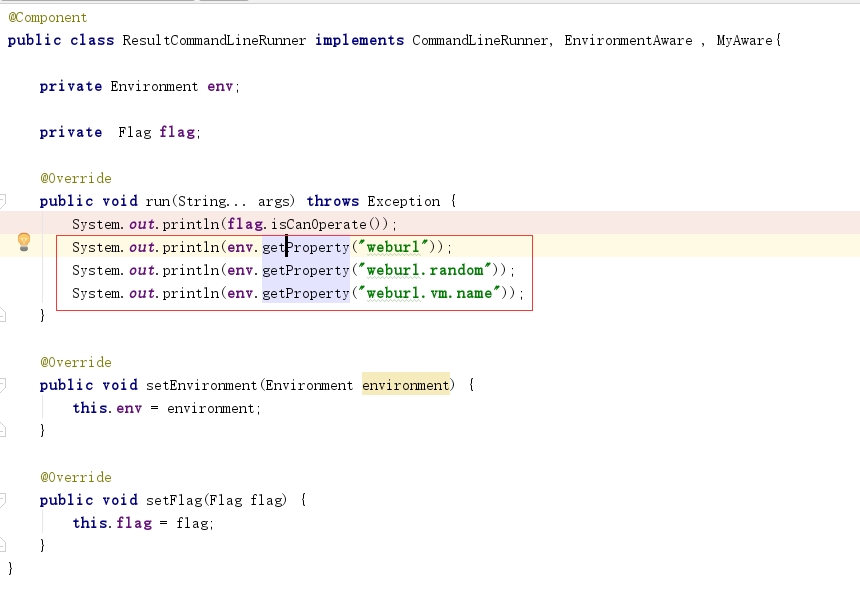
下面我们介绍下environment的使用
1、进入启动方法run,定位到prepareEnvironment方法
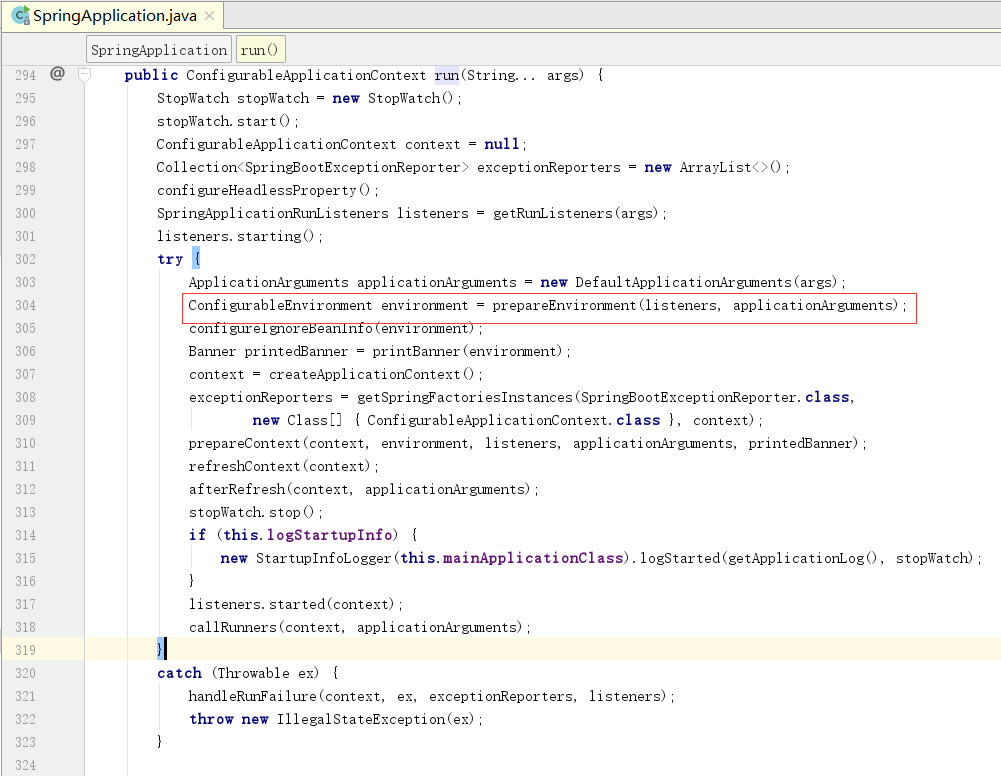
2、进到prepareEnvironment方法

3、进入getOrCreateEnvironment方法。实例化了StandardServletEnvironment
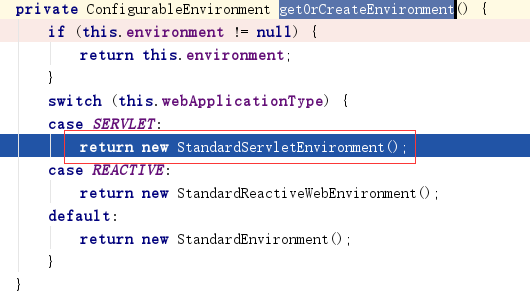
进入父类AbstractEnvironment的构造函数

1)、进入customizePropertySources方法。
增加servletConfigInitParams属性源和servletContextInitParams属性源,添加jndi属性源
然后调用父类的super.customizePropertySources(propertySources);
1 2 3 4 5 6 7 8 9 | protected void customizePropertySources(MutablePropertySources propertySources) { propertySources.addLast(new StubPropertySource("servletConfigInitParams")); propertySources.addLast(new StubPropertySource("servletContextInitParams")); if(JndiLocatorDelegate.isDefaultJndiEnvironmentAvailable()) { propertySources.addLast(new JndiPropertySource("jndiProperties")); } super.customizePropertySources(propertySources);} |
2)、进入customizePropertySources,增加两个属性源(系统属性源和系统环境属性源)
1 2 3 4 5 6 | protected void customizePropertySources(MutablePropertySources propertySources) { propertySources.addLast( new PropertiesPropertySource(SYSTEM_PROPERTIES_PROPERTY_SOURCE_NAME, getSystemProperties())); propertySources.addLast( new SystemEnvironmentPropertySource(SYSTEM_ENVIRONMENT_PROPERTY_SOURCE_NAME, getSystemEnvironment()));} |
里面getSystemProperties方法,主要有Java的版本号,Java虚拟机名称等

4、然后回到configureEnvironment方法
1 2 3 4 5 6 7 8 | protected void configureEnvironment(ConfigurableEnvironment environment, String[] args) { if (this.addConversionService) { ConversionService conversionService = ApplicationConversionService.getSharedInstance(); environment.setConversionService((ConfigurableConversionService) conversionService); } configurePropertySources(environment, args); configureProfiles(environment, args);} |
1) 进入configurePropertySources(environment, args);
1 2 3 4 5 6 7 8 9 10 11 12 13 14 15 16 17 18 19 20 | protected void configurePropertySources(ConfigurableEnvironment environment, String[] args) { MutablePropertySources sources = environment.getPropertySources(); if (this.defaultProperties != null && !this.defaultProperties.isEmpty()) { sources.addLast(new MapPropertySource("defaultProperties", this.defaultProperties)); } if (this.addCommandLineProperties && args.length > 0) { String name = CommandLinePropertySource.COMMAND_LINE_PROPERTY_SOURCE_NAME; if (sources.contains(name)) { PropertySource<?> source = sources.get(name); CompositePropertySource composite = new CompositePropertySource(name); composite.addPropertySource( new SimpleCommandLinePropertySource("springApplicationCommandLineArgs", args)); composite.addPropertySource(source); sources.replace(name, composite); } else { sources.addFirst(new SimpleCommandLinePropertySource(args)); } }} |
这个方法主要是添加defaultProperties默认属性源(sources.addLast(new MapPropertySource("defaultProperties", this.defaultProperties));
)和命令属性源sources.addFirst(new SimpleCommandLinePropertySource(args));
进入SimpleCommandLinePropertySource的构造函数
1 2 3 | public SimpleCommandLinePropertySource(String... args) { super(new SimpleCommandLineArgsParser().parse(args));} |
里面调用了parse函数。命令的定义是我们前面介绍过的。解析命令的时候,判断是否以“--”开头
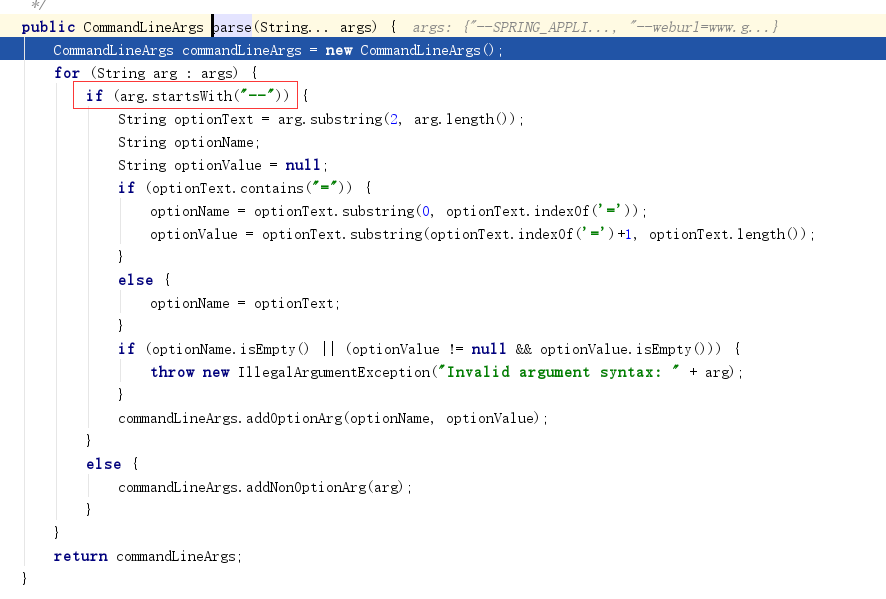
2) 进入configureProfiles。profile我们后面在进行介绍 SpringBoot Profile源码介绍
1 2 3 4 5 6 7 | protected void configureProfiles(ConfigurableEnvironment environment, String[] args) { environment.getActiveProfiles(); // ensure they are initialized // But these ones should go first (last wins in a property key clash) Set<String> profiles = new LinkedHashSet<>(this.additionalProfiles); profiles.addAll(Arrays.asList(environment.getActiveProfiles())); environment.setActiveProfiles(StringUtils.toStringArray(profiles));} |
3、 listeners.environmentPrepared(environment)
发布environmentPrepared事件,这里就是监听器的实现。进入environmentPrepared方法
1 2 3 4 5 | public void environmentPrepared(ConfigurableEnvironment environment) { for (SpringApplicationRunListener listener : this.listeners) { listener.environmentPrepared(environment); }} |
进入listener.environmentPrepared(environment);里面调用广播器广播一个事件
1 2 3 4 5 | @Overridepublic void environmentPrepared(ConfigurableEnvironment environment) { this.initialMulticaster .multicastEvent(new ApplicationEnvironmentPreparedEvent(this.application, this.args, environment));} |
进入广播事件方法。
1 2 3 4 5 6 7 8 9 10 11 12 | public void multicastEvent(final ApplicationEvent event, @Nullable ResolvableType eventType) { ResolvableType type = (eventType != null ? eventType : resolveDefaultEventType(event)); Executor executor = getTaskExecutor(); for (ApplicationListener<?> listener : getApplicationListeners(event, type)) { if (executor != null) { executor.execute(() -> invokeListener(listener, event)); } else { invokeListener(listener, event); } }} |
在此方法中,获得对该事件感兴趣的监听器,遍历监听器,调用invokeListener方法。
监听器的部分在前面已经介绍过了,这里我们主要看下监听器都做了什么?
进入doInvokeListener方法
1 2 3 4 5 6 7 8 9 10 11 12 13 14 15 16 17 18 19 | private void doInvokeListener(ApplicationListener listener, ApplicationEvent event) { try { listener.onApplicationEvent(event); } catch (ClassCastException ex) { String msg = ex.getMessage(); if (msg == null || matchesClassCastMessage(msg, event.getClass())) { // Possibly a lambda-defined listener which we could not resolve the generic event type for // -> let's suppress the exception and just log a debug message. Log logger = LogFactory.getLog(getClass()); if (logger.isTraceEnabled()) { logger.trace("Non-matching event type for listener: " + listener, ex); } } else { throw ex; } }} |
然后进入listener.onApplicationEvent(event);方法
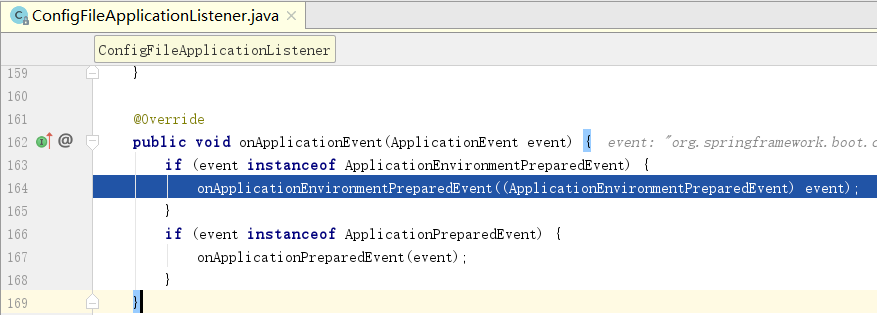
然后进入onApplicationEnvironmentPreparedEvent方法

方法loadPostProcessors是获得属性文件中对该监听器的实现类有哪些。
1 2 3 | List<EnvironmentPostProcessor> loadPostProcessors() { return SpringFactoriesLoader.loadFactories(EnvironmentPostProcessor.class, getClass().getClassLoader());} |
该配置文件配置如下:

配置文件由三个EnvironmentPostProcessor,在把当前的添加进去postProcessors.add(this);就有四个了。然后依次遍历这四个EnvironmentPostProcessor

我们进入其中一个EnvironmentPostProcessor,如ConfigFileApplicationListener。里面调用了addPropertySources(environment, application.getResourceLoader());
1 2 3 4 | @Overridepublic void postProcessEnvironment(ConfigurableEnvironment environment, SpringApplication application) { addPropertySources(environment, application.getResourceLoader());} |
然后进入addPropertySources方法
1 2 3 4 | protected void addPropertySources(ConfigurableEnvironment environment, ResourceLoader resourceLoader) { RandomValuePropertySource.addToEnvironment(environment); new Loader(environment, resourceLoader).load();} |
RandomValuePropertySource.addToEnvironment(environment);这个方法添加了一个随机的属性源
1 2 3 4 5 | public static void addToEnvironment(ConfigurableEnvironment environment) { environment.getPropertySources().addAfter(StandardEnvironment.SYSTEM_ENVIRONMENT_PROPERTY_SOURCE_NAME, new RandomValuePropertySource(RANDOM_PROPERTY_SOURCE_NAME)); logger.trace("RandomValuePropertySource add to Environment");} |
然后进入new Loader(environment, resourceLoader).load();的load方法。添加application-profile.(properties|yml)属性集
1 2 3 4 5 6 7 8 9 10 11 12 13 14 15 16 17 18 | public void load() { this.profiles = new LinkedList<>(); this.processedProfiles = new LinkedList<>(); this.activatedProfiles = false; this.loaded = new LinkedHashMap<>(); initializeProfiles(); while (!this.profiles.isEmpty()) { Profile profile = this.profiles.poll(); if (profile != null && !profile.isDefaultProfile()) { addProfileToEnvironment(profile.getName()); } load(profile, this::getPositiveProfileFilter, addToLoaded(MutablePropertySources::addLast, false)); this.processedProfiles.add(profile); } resetEnvironmentProfiles(this.processedProfiles); load(null, this::getNegativeProfileFilter, addToLoaded(MutablePropertySources::addFirst, true)); addLoadedPropertySources();} |
关于profile留在后面介绍。 SpringBoot Profile源码介绍
4、bindToSpringApplication(environment);
进入bindToSpringApplication方法
1 2 3 4 5 6 7 8 | protected void bindToSpringApplication(ConfigurableEnvironment environment) { try { Binder.get(environment).bind("spring.main", Bindable.ofInstance(this)); } catch (Exception ex) { throw new IllegalStateException("Cannot bind to SpringApplication", ex); }} |
5、environment = new EnvironmentConverter(getClassLoader()).convertEnvironmentIfNecessary(environment, deduceEnvironmentClass());
使用判断convertEnvironmentIfNecessary当前环境是否是指定类型,是的话就返回。否的话再new一个环境,把值赋值到新的实例化的环境中
1 2 3 4 5 6 7 8 9 10 11 12 13 14 15 16 | StandardEnvironment convertEnvironmentIfNecessary(ConfigurableEnvironment environment, Class<? extends StandardEnvironment> type) { if (type.equals(environment.getClass())) { return (StandardEnvironment) environment; } return convertEnvironment(environment, type);}private StandardEnvironment convertEnvironment(ConfigurableEnvironment environment, Class<? extends StandardEnvironment> type) { StandardEnvironment result = createEnvironment(type); result.setActiveProfiles(environment.getActiveProfiles()); result.setConversionService(environment.getConversionService()); copyPropertySources(environment, result); return result;} |
6、ConfigurationPropertySources.attach(environment); 增加configurationProperties属性源
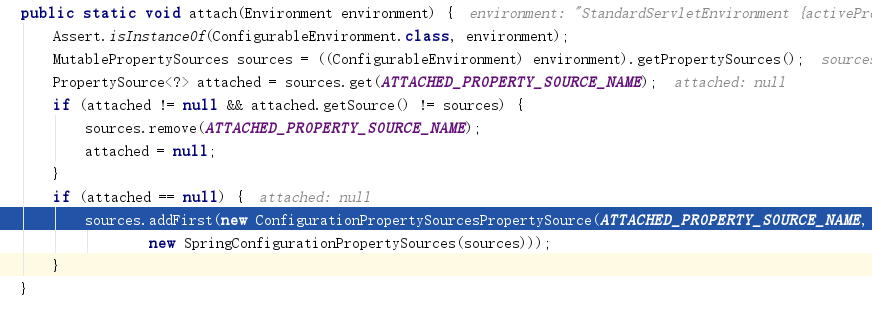
作者:Work Hard Work Smart
出处:http://www.cnblogs.com/linlf03/
欢迎任何形式的转载,未经作者同意,请保留此段声明!





· 10年+ .NET Coder 心语,封装的思维:从隐藏、稳定开始理解其本质意义
· .NET Core 中如何实现缓存的预热?
· 从 HTTP 原因短语缺失研究 HTTP/2 和 HTTP/3 的设计差异
· AI与.NET技术实操系列:向量存储与相似性搜索在 .NET 中的实现
· 基于Microsoft.Extensions.AI核心库实现RAG应用
· 阿里巴巴 QwQ-32B真的超越了 DeepSeek R-1吗?
· 10年+ .NET Coder 心语 ── 封装的思维:从隐藏、稳定开始理解其本质意义
· 【译】Visual Studio 中新的强大生产力特性
· 【设计模式】告别冗长if-else语句:使用策略模式优化代码结构
· 字符编码:从基础到乱码解决
2019-03-01 备忘录模式
2014-03-01 XAMPP 在windows下无法启动Apache解决方案